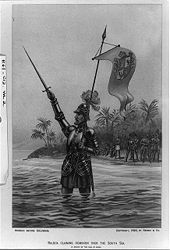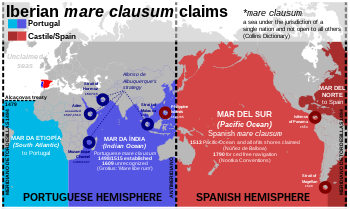South Seas
Today the termSouth Seas,orSouth Sea,most commonly refers to the portion of thePacific Oceansouth of theequator.[1][2][3]The term South Sea may also be usedsynonymouslyforOceania,or even more narrowly forPolynesiaor thePolynesian Triangle,an area bounded by theHawaiian Islands,New ZealandandEaster Island.Pacific Islandersare commonly referred to asSouth Sea Islanders,particularly inAustralia.
The term was first coined asMar de Sur,or “South Sea,” by SpanishconquistadorVasco Núñez de Balboain 1513 and was applied to the entire area of today's Pacific Ocean. In 1520,Ferdinand Magellannamed the same ocean the Pacific Ocean, and over time Magellan's name became more well-known.
Origin
[edit]
The SpanishconquistadorVasco Núñez de Balboacoined the term "South Sea" when he traveled across theIsthmus of Panamaand reached theBay of San Miguel,naming the ocean aheadMar del Sur( "South Sea" ) due to its location along the southern shore of the isthmus.[4]

Núñez de Balboa and his soldiers attempted to travel to the peak of the mountain to see the sea, but when they arrived at the foot of the mountain only 69 out of 190 soldiers had survived the journey. Balboa did not want to share the experience of being the first to see the unknown ocean and so he commanded his crew to remain at the foot of the mountain and wait. He then became the first European to see the Pacific Ocean on 25 September 1513. After looking at the ocean alone for some time, he told his crew to come up to join him.[3][4]
After he set foot into the ocean, at the opening of the Saban river he declared theSouth Sea,and all adjoining lands to be property of his king.[4]
Literature and film
[edit]A genre of literature and filmhas developed around the South Seas because it is often seen as an idealized and romanticized region of the world.
In 1773, whenJames Cookcame to Tahiti for the second time, he was accompanied byJohann Reinhold ForsterandGeorg Forster,two German scientists.
- "What a morning—impossible to be described more beautifully by any poet—when we saw the isle O-Taheiti two miles ahead of us."
The reports of the discoveries determined the Europeans' picture of the South Seas for a long time. On those grounds,Joseph Bankswrote:
- "An Arcadia of which we will be king."
Louis Antoine de Bougainville's romantic travel reportVoyage autour du mondeand Georg Forster's travel descriptionA Voyage Round the World(1777) confirmedJean-Jacques Rousseau's image of the "noble savage".He describes the country as"jardin d’Eden "(Garden of Eden), which provided his residents with everything required to live. He saw the islanders as pure humans who were not yet poisoned by civilization. The reportVoyage autour du mondeinspiredDenis Diderotto write his essaySupplément au voyage de Bougainville,a plea for sexual freedom.
Paul Gauguin,a French artist, contributed to the idea of a Garden of Eden by creating paintings of exotic paradises rather than as they really were.
The German writer Erich Scheurmann also utilized this imagery when he created fictional travel reports of a South Seas chief that were published between 1915 and 1920 under the titleThe Papalagi.The book gained popularity fifty years after it was published and sold more than 1.7 million copies inGermanalone.
Drawings and paintings
[edit]Joseph BankshiredSydney Parkinson,a nature draftsman, andAlexander Buchan,landscape painter, to accompanyJames Cook's first expedition to the Pacific (1768 –1771) and to record the discoveries that were made. Parkinson and Buchan depicted the people living on theSociety Islands,the coasts ofNew Zealand,and onEaster Islandand their environments in drawings and paintings. The painterWilliam Hodgesaccompanied Captain Cook on his second expedition to the South Seas, New Zealand,Tonga,the Society Islands,Melanesia,and Easter Island among others. During Cook's third expedition to the South Seas,John Webberpainted South Sea motifs on theCook Islands,TahitiandHawaii,among other places.
-
Old map of Peru with theMar del Sur
-
William Hodges:ResolutionandAdventurewith a fishing boat in the bay by Matawai(Tahiti), Oil on canvas, 1776 (National Maritime Museum,London)
-
John Webber:A View in Ulietea (Raiatea),(French Polynesia), Watercolor with pencil and ink, without year (National Maritime Museum,London)
-
Paul Gauguin:No te aha oe riri( "Why are you angry?" ), Oil on canvas, 1896 (The Art Institute of Chicago)
-
Emil Nolde:South Sea Islander (Südsee-Insulaner II),Color lithograph 1915 (Brooklyn Museum)
-
Ingo Kühl:The Sea IV,Oil on canvas, 2012, painted in Vanuatu
Paul Gauguinreached Tahiti in April 1891 and painted 66 paintings during his time there. He left the island in early 1892 due to health problems and brief difficulties and later returned to Paris to travel toPapeetein September 1895. He died in 1903 on theMarquesas.
Gauguin is considered a pioneer ofExpressionism because of hisSouth Sea paintings. Other artists that traveled to areas within the South Seas includeEmil Nolde,Max Pechstein,Henri Matisse,Per Kirkeby,and most recently artistIngo Kühl.
Other usages of the term "South Seas"
[edit]TheSouth Seas Mandatewas the name of the Japanese mandate over certain islands followingWorld War I.
The "South Seas trade"was a term used in Britain in the nineteenth century to denote sealing, whaling, island trading and other commercial ship-based activities in the Pacific.
See also
[edit]References
[edit]- ^Spate, O. H. K. (1977)."'South Sea' to 'Pacific Ocean': A Note on Nomenclature ".The Journal of Pacific History.12(4): 205–211.JSTOR25161059.Retrieved21 March2023.
- ^"South of What?".Mapping Sovereignty.Duke University.Retrieved21 March2023.
- ^abMaroto Camino, Mercedes (2005).Producing the Pacific: Maps and Narratives of Spanish Exploration (1567-1606).Brill. p. 76.ISBN9789401202923.Retrieved21 March2023.
- ^abcPolk, Dora Beale (1991).The Island of California: A History of The Myth(1995 reprint ed.). Spokane, Washington:Arthur H. Clark Company.pp. 67–76.ISBN0-8032-8741-0.






